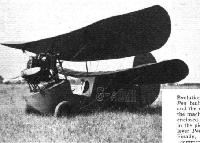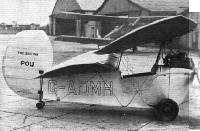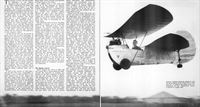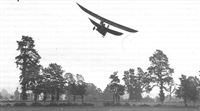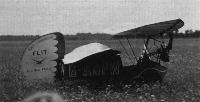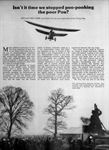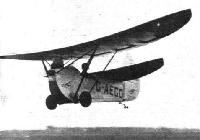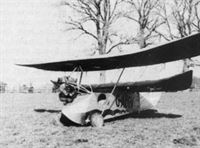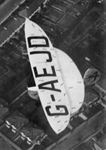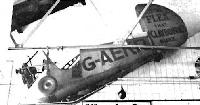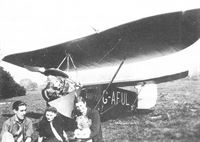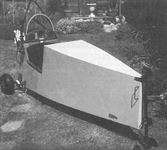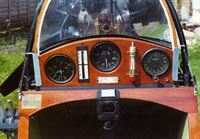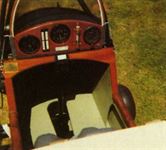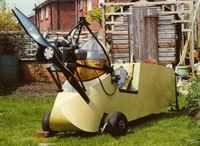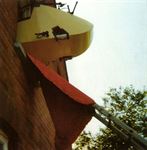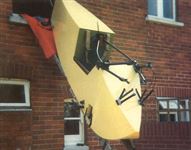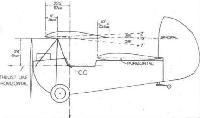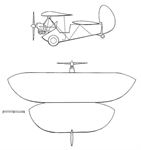
Mignet Pou-de-Ciel
Ультралегкий самолет Pou-du-Ciel француза Анри Минье, название которого буквально означало "небесная вошь", но чаще переводится как "небесная блоха", стал одной из первых машин, чертежи которой легко могли достать конструкторы-любители. Анри Минье и сам был таким любителем-энтузиастом, не имел опыта постройки самолетов и, в общем-то, игнорировал накопленный опыт в аэродинамике и конструкции при создании своего проекта. Его целью и мечтой было разработать простой в постройке и пилотировании самолет, который бы позволил тысячам любителей-энтузиастов подняться в небо при минимальных затратах. Прежде всего, он постарался увеличить устойчивость, используя фюзеляж с низким расположением центра тяжести, затем установил два крыла, переднее и заднее, отказавшись от горизонтального оперения. Угол атаки переднего крыла мог меняться для управления по тангажу. Анри Минье полагал, что большое поперечное V крыльев обеспечит достаточную устойчивость, и установил большой руль направления. Пилот имел единственную ручку, передвижение которой в продольном направлении управляло самолетом по тангажу, а в поперечном - по курсу. Затем Минье выпустил руководство с чертежами и инструкцией по постройке самолета. Вскоре множество энтузиастов по всей Европе, особенно во Франции, Германии, СССР, Италии, Скандинавии и Британии были заняты изготовлением собственных машин. Ряд катастроф привел к запрету полетов на этом самолете во Франции. Изучив проблему, специалисты выдали ряд рекомендаций, но разразившаяся Вторая мировая война поставила крест на любительской постройке аэропланов.
<...>
Описание:
- Mignet Pou-de-Ciel
- Flight, September 1934
SIMPLIFIED FLYING - Flight, April 1935
PAVING the WAY for the "POU" - Flight, August 1935
L'AUTRE AVIATION - Flight, April 1936
MODERN LIGHT AIRCRAFT REVIEW - Flight, May 1936
A CANTILEVER "POU"
Фотографии
-
Мировая Авиация 190
Регистрационный номер: G-AEBB [3] Многочисленные "Блохи", подобные этой, летали в Великобритании, пока по соображениям безопасности не был наложен запрет на их эксплуатацию.
-
Aeroplane Monthly 1993-08 / M.Oakey - Grapevine
Регистрационный номер: G-ADVU Mignet Flying Flea “G-ADVU” / BAPC-211, newly completed by Ken Fern at Stoke-on-Trent, has been on static display at the Congleton garage of project sponsor Ian Burns, whose father built and flew one (unregistered) in the Thirties.
-
Aeroplane Monthly 1996-08 / 1996 UK Aircraft Collections and Museums Guide (2)
Регистрационный номер: G-ADRX Beautifully restored Pou-du-Ciel “G-ADRX" at the RAF Millom Museum.
-
Aeroplane Monthly 1997-06 / G.Jones - The Flea fights back
Could be the mid-1930s rather than 1992 at Luskintyre, New South Wales, Australia. Bob Cornwell’s completed Flea stands next to period pumps.
-
Aeroplane Monthly 1998-12 / M.Oakey, T.Harmsworth - News
The Museum Orleans showed its Mignet H.M.14 Pou-du-Ciel, rebuilt in 1994.
-
Aeroplane Monthly 1997-06 / G.Jones - The Flea fights back
Jacques Laurent’s Rennes based Rotax 447-powered H.M.14 hops into the air at Marennes in August 1993.
-
Flight 1935-08 / Flight
M. Mignet "trundling" his "Pou" on Lympne aerodrome. The engine is an Aubier et Dunne two-stroke.
-
Aeroplane Monthly 1993-11 / H.Shore - Flea fever (1)
The master himself; Henri Mignet about to fly an H.M.14 Pou-du-Ciel at Orly in October 1935. This “Flea” was fitted with a three-cylinder Aubier et Dunne engine, developing 28 h.p. at 3,400 r.p.m.
-
Aeroplane Monthly 1995-12 / I.Harwood - Fleas over Popham
Henri Mignet’s H.M.14 Pou du Ciel during his 1935 Daily Express-sponsored tour of Britain. He arrived on the evening of August 13, having flown from St Inglevert to Lympne in 52min.
-
Flight 1935-08 / Flight
PORTRAIT OF A PIONEER : A remarkable photograph of M. Henri Mignet flying his "Pou-du-Ciel."
-
Aeroplane Monthly 1982-02 / A.Ord-Hume - Isn't it time we stopped poo-poohing the pour Pou? (2)
Mignet flying his HM14 at Orly in October 1935.
-
Aeroplane Monthly 1995-12 / I.Harwood - Fleas over Popham
Henri Mignet flying his H.M.14 during his Daily Express-sponsored tour of Britain. The H.M.14 was powered by a 17 h.p. Aubier et Dunne engine.
-
Flight 1935-08 / Flight
1909-1935! As then so now, a French pioneer crosses the Channel in a machine of his own creation. At. Henri Mignet in his "Pou-du-Ciel" approaching Folkestone on August 13th.
-
Flight 1935-03 / Flight
The Mignet Pou-du-Ciel in flight
-
Aeroplane Monthly 1995-12 / I.Harwood - Fleas over Popham
Henri Mignet in his H.M.14 during his 1935 British tour. Born in 1893, Mignet died of cancer on August 31, 1965.
-
Flight 1935-08 / Flight
A Pioneer's "Pou." M. Henri Mignet, designer, or, one might say, inventor, of the "Pou-du-Ciel" with his personal machine. The engine is an Aubier et Dunne.
-
Aeroplane Monthly 1982-01 / A.Ord-Hume - Isn't it time we stopped poo-poohing the pour Pou? (1)
Bereted Henri Mignet sitting behind a whining Aubier et Dunne, whilst the French crowd stand transfixed with amazement.
-
Flight 1935-10 / Flight
M. Mignet's installation of the new three-cylinder Aubier-Dunne engine. Note the three carburetters, and the air scoop for cylinder cooling.
The French 22 h.p. Aubier et Dunne was fitted to Mignet’s cross-Channel Flea. -
Flight 1935-11 / Flight
The Pou, says our contributor, "is rather ugly and so full of wires you cannot get in" Here is the machine and its originator, M. Henri Mignet
-
Flight 1936-04 / Flight
The Scott Flying Squirrel is particularly suitable for Pou-du-Ciel. At 2,800 r.p.m. (normal) it gives 16 h.p., but at 5,200 r.p.m. the power is 34 h.p.
The 25 h.p. Scott Flying Squirrel engine, a version of the motor cycle engine, was designed expressly for the Flea. -
Flight 1935-10 / Flight
Raymond Pic's Pou equipped with a flat-twin Clerget engine of 16 h.p. has a neatly faired-in nose. He retains the rubber tensioners attached to the leading edge.
-
Aeroplane Monthly 1988-03 / P.Underhill - Birth of a Bebe
Edouard Joly's Pou has a 35 h.p. flat-twin Poinsard engine
Edouard Joly's Mignet Pou-du-Ciel about to be started at the Orly Flea meeting in October 1935. The engine was a 25 h.p. flat-twin Poinsard. -
Aeroplane Monthly 1982-03 / S.Appleby - On home-made wings
A signed photograph presented by Mignet to the author and inscribed, “To my old friend S. V. Appleby, who has just finished an HM8 ‘D’ and which flies perfectly. Souvenir of the Pou du Ciel”
-
Aeroplane Monthly 1982-03 / S.Appleby - On home-made wings
Appleby seated in a four-metre span Pou at Maux, France. Along the wing leading edge is written: “Le plus petit avion du monde” - the smallest aeroplane in the world.
-
Flight 1935-07 / Flight
A BRITISH "POU" FLIES. The Flight photographs above show Mr. Appleby with his Pou-du-Ciel (special 10 h.p. Ford engine) and (in circle) during one of his initial "hops" at Heston a few days agp. On the right is the "Pou" built by Mr. Philip Priest of Huddersfield, with the help of his cousins, Allen, Kenneth, and Geoffrey; its behaviour during experimental taxying has been promising. At present it is fitted with a Douglas motor cycle engine, but awaits a special Scott unit, as does the Pou built by Messrs. C. Brooke, A. Morton and F. Lawton, also in Huddersfield. Mr. Priest says that he and Mr. Brooke have each spent about ?30 on their "Pous," so, unless the matter of a C. of A. proves troublesome, the total cost, with engine, should be about ?75 in each case.
-
Aeroplane Monthly 1982-03 / S.Appleby - On home-made wings
Регистрационный номер: G-ADMH [22] Appleby in his Flea G-ADMH at Heston in August 1935. Note the uncowled Carden Ford engine.
-
Aeroplane Monthly 1981-11 / Skywriters
Регистрационный номер: G-ADMH [22] Stephen Appleby sitting in his yet unregistered Flea G-ADMH at Heston in June 1935. Sir John Carden is seen at left.
-
Flight 1936-10 / Flight
Регистрационный номер: G-ADMH [22] Evolution: The photograph shows the first British Pou built by Mr. S. V. Appleby. Note the exposed engine and the radiator in front of the pilot's face. After a crash the machine was rebuilt with the engine lowered and partly enclosed, and the radiator in the nose of the fuselage.
-
Мировая Авиация 190
Регистрационный номер: G-ADMH [22] Этот самолет G-ADMH был построен и облетан Стивеном Эпплби. Он был известен в Британии как "Appleby Flea" (Блоха Эпплби).
-
Aeroplane Monthly 1982-03 / S.Appleby - On home-made wings
Регистрационный номер: G-ADMH [22] G-ADMH at Heston in 1935.
-
Aeroplane Monthly 1982-03 / S.Appleby - On home-made wings
Регистрационный номер: G-ADMH [22] Mr. S. V. Appleby took off from Heston aerodrome in his Carden-engined "Pou" -
The author's Flea G-ADMH in original form with uncowled Carden Ford engine. -
Aeroplane Monthly 1984-07 / J.Viner - The great Flea race
Регистрационный номер: G-ADMH [22] A small boy watches as Stephen Appleby demonstrates his Flea G-ADMH, the first British-built Pou du Ciel to be completed. The registration of the Flea was cancelled in 1938. Stephen Appleby is still with us; we wonder what happened to the little boy!
-
Flight 1935-08 / Flight
Регистрационный номер: G-ADMH [22] - and landed in an allotment just outside. The plough furrows proved his undoing. On grass he would probably have landed safely. Even as it was, surprisingly little damage was done.
-
Aeroplane Monthly 1981-11 / Skywriters
Регистрационный номер: G-ADMH [22] The same Flea after overturning in a ploughed field near Heston on July 29, 1935. Had the Flea landed on grass it would probably not have turned over.
-
Flight 1935-12 / Flight
Регистрационный номер: G-ADMH [22] A side view - note how the sides of the cockpit, previously open, have been filled in.
-
Aeroplane Monthly 1982-03 / S.Appleby - On home-made wings
Регистрационный номер: G-ADMH [22] -
Flight 1935-10 / Flight
Регистрационный номер: G-ADMH [22] The placing of the radiator in the fuselage nose gives a much neater appearance.
-
Aeroplane Monthly 1982-03 / S.Appleby - On home-made wings
Регистрационный номер: G-ADMH [22] Sir John Carden stands with the author and G-ADMH at Heston in 1935.
-
Aeroplane Monthly 1982-03 / S.Appleby - On home-made wings
Регистрационный номер: G-ADMH [22] Bereted Stephen Appleby at Lympne on December 5, 1935 just prior to his Channel flight.
-
Flight 1935-10 / Flight
Регистрационный номер: G-ADMH [22] This Pou is now a steady flier, even in gusty weather.
-
Aeroplane Monthly 1982-01 / A.Ord-Hume - Isn't it time we stopped poo-poohing the pour Pou? (1)
Регистрационный номер: G-ADMH [22] Evolution: After a crash the machine was rebuilt with the engine lowered and partly enclosed, and the radiator in the nose of the fuselage.
Stephen Appleby obviously delighted with the performance of his re-built Flea, modified by L. E. Baynes and powered by a repositioned 30 h.p. at Carden-Ford engine, Heston in August 1935. -
Aeroplane Monthly 1982-03 / S.Appleby - On home-made wings
Регистрационный номер: G-ADMH [22] After modification by L. E. Baynes. Note lengthened wings and enclosed engine and radiator.
-
Flight 1936-03 / Flight
Регистрационный номер: G-ADMH [22] THIS ONE FLIES! Remembering the general tendency to be humorous at the expense of the Pou, here is photographic evidence of the fact that the Carden-engined model flies - and flies well. Mr. S. V. Appleby, of course, is the pilot. A reasonable supply of power with careful construction and rigging help to explain its successful performance; one of the rigid incidence control rods can be clearly seen.
-
Aeroplane Monthly 1982-03 / S.Appleby - On home-made wings
Регистрационный номер: G-ADMH [22] Stephen Appleby crossing the English Channel in his Flea, G-ADMH, on December 5, 1935.
To say that Mr. S. V. Appleby had an escort on his Channel flight would do an injustice to his 70 m.p.h. Pou. -
Aeroplane Monthly 1982-03 / S.Appleby - On home-made wings
Регистрационный номер: G-ADMH [22] The author crosses the coast of France on his way to St Inglevert, where he landed 35min after leaving Lympne, Kent.
-
Air Enthusiast 1997-03 / B.Marshall - The 'Flea' and Me
Регистрационный номер: G-ADMH [22] Photographs of ‘Fleas’ in the air are quite rare. An enchanting shot of a Carden Ford-powered example amid a British pastoral scene. This is possibly Stephen Appleby flying G-ADMH after it was modified by L E ‘Baron’ Baynes.
-
Aeroplane Monthly 1991-10 / Personal album. Civil
Регистрационный номер: G-ADPV Mignet H.M.14 Pou-du-Ciel (we called them Flying Fleas) G-ADPV was built by E. G. Perman Ltd at their Mews premises in Gray's Inn Road in London. Built for E. W. Cavendish, 'PV was fitted with a 25 h.p. Scott Squirrel and is almost certainly seen here at its Heston base. Perman built 11 Fleas at the time; powerplants included the Anzani and the firm’s own Perman-Ford as well as the Squirrel.
-
Air International 1983-11
Регистрационный номер: G-ADPW The photograph of the Pou du Ciel G-ADPW supplied by Mr Herman.
-
Aeroplane Monthly 1982-02 / A.Ord-Hume - Isn't it time we stopped poo-poohing the pour Pou? (2)
Регистрационный номер: G-ADPX [3] Mr. Appleby flying over the newsreel cameras.
The Perman-Ford powered Perman Pou, G-ADPX, seen performing for the "movie" cameras at a meeting near Southend in April 1936. -
Air Enthusiast 1997-03 / B.Marshall - The 'Flea' and Me
Регистрационный номер: G-ADVM The Planes Ltd HM.14 ‘Flea’ G-ADVM, presumably at Ingatestone. A young Bert Marshall is at the controls, the man with his hands on the propeller is thought to be Harold Bowen.
-
Aeroplane Monthly 1995-08 / D.Menzies - Highland Flea
Регистрационный номер: G-ADWX [4] Mr Lamb’s Mignet H.M.14 is hitched on to a car to be towed to a suitable field for flight tests. The designation F.B.1 on the rudder signifies Fraser Brothers No 1, referring to the Dingwall coachbuilders responsible for construction of the fuselage and wings of G-ADWX. The type numbers appear to have ended at that point.
-
Aeroplane Monthly 1995-08 / D.Menzies - Highland Flea
Регистрационный номер: G-ADWX [4] G-ADWX ready for towing, with its wings supported above the fuselage in a fore-and-aft position to keep the width to a minimum.
-
Aeroplane Monthly 1995-08 / D.Menzies - Highland Flea
Регистрационный номер: G-ADWX [4] Mr Lamb’s completed Flea, minus propeller. It was powered by a 25 h.p. Scott Squirrel engine.
-
Aeroplane Monthly 1995-08 / D.Menzies - Highland Flea
Регистрационный номер: G-ADWX [4] The long exhaust extending beneath the cockpit on the starboard side is evident here. Following the Flea’s crash, the registration was cancelled as “lapsed" in 1945.
-
Air Pictorial 1961-10
Регистрационный номер: G-ADXS [2] Built by C. L. Storey late in 1935, Pou du Ciel G-ADXS is now on display in Storey's Garage, Alexandria Street, Southend-on-Sea.
-
Aeroplane Monthly 1986-01 / 1986 UK Aircraft Collections and Museums Guide
Регистрационный номер: G-ADXS [2] Mignet H.M. 14 Pou-du-Ciel G-ADXS.
-
Aeroplane Monthly 1984-07 / J.Viner - The great Flea race
Mr. S. V. Appleby, flying the Putnam Flea, indulges in a little formation work with an Aeronca;
Aeronca C-3 G-ADYR dices with a Flea while an elderly gentleman tries out the Flea Taxying Machine's cockpit for size. This device had insufficient power to fly but gave those in search of adventure a quick thrill, though one very small boy managed to get the contraption airborne at an earlier meeting.Другие самолёты на фотографии: Aeronca C - США - 1929
-
Jane's All the World Aircraft 1980 / Encyclopedia of Aviation - Aircraft A-Z - v4
Регистрационный номер: G-AEBB [3] Mignet Pou du Ciel.
-
Air Pictorial 1968-11
Регистрационный номер: G-AEBB [3] Pou du Ciel G-AEBB at the Shuttleworth Air Pageant, Old Warden 8/9/68
-
Flight 1936-04 / Flight Advertisements
Регистрационный номер: G-AEEC -
Aeroplane Monthly 1982-02 / A.Ord-Hume - Isn't it time we stopped poo-poohing the pour Pou? (2)
Регистрационный номер: G-AEEH Squirrel-powered Pou G-AEEH built at Bath in 1936.
-
Flight 1936-08 / Flight
Регистрационный номер: G-AEFV A Pou on test in the large wind tunnel at Farnborough.
-
Aeroplane Monthly 1988-03 / J.Battison - Flea circus
Регистрационный номер: G-AEFW [3] A later picture of the Aero-Eight Club's Flea, showing it marked correctly as G-AEFW.
-
Flight 1936-05 / Flight
Регистрационный номер: G-AEGD [3] In aerodynamic design the new machine is a big step forward in Pou development. The 30 h.p. Carden engine is neatly installed.
-
Flight 1936-10 / Flight
Регистрационный номер: G-AEGD [3] The Abbott-Baynes Cantilever Pou with 30 h.p. Carden engine.
-
Aeroplane Monthly 1980-07
Регистрационный номер: G-AEGD [3] Mr. Stephen Appleby, in the new cantilever Pou, passes the time of day with Flight's photographer at Heston.
Flight shot of Stephen Appleby flying the Abbott-Baynes cantilever-winged Pou du Ciel (Flying Flea), was taken at Heston on May 4, 1936 -
Aeroplane Monthly 1974-11 / J.Wood - Seventy hours of Dronish delight
Регистрационный номер: G-AEGV The Flea that the author first soloed in. It is shown as it is today, with wrong engine. The original Douglas Sprite was used by the Drone syndicate as a spare. The Flea is today owned by the Midland Aircraft Preservation Society.
-
Aeroplane Monthly 1988-01 / Mignet H.M.14 Pou du Ciel G-AEHM /Preservation Profile/
Регистрационный номер: G-AEHM [5] Early photograph of Harry Dolman’s Flea, G-AEHM. The engine is a 35 h.p. ABC Scorpion.
-
Aeroplane Monthly 1988-01 / Mignet H.M.14 Pou du Ciel G-AEHM /Preservation Profile/
Регистрационный номер: G-AEHM [5] 'HM pictured at Wroughton on June 27, 1986.
-
Aeroplane Monthly 1988-01 / Mignet H.M.14 Pou du Ciel G-AEHM /Preservation Profile/
Регистрационный номер: G-AEHM [5] ADRIAN BALCH'S plate was also taken at Wroughton, current home of the Flea.
-
Aeroplane Monthly 1988-01 / Mignet H.M.14 Pou du Ciel G-AEHM /Preservation Profile/
Регистрационный номер: G-AEHM [5] G-AEHM on exhibition at the Daily Express “50 Years of Flying” event, held at Hendon Aerodrome on July 21, 1951.
-
Aeroplane Monthly 1988-01 / Mignet H.M.14 Pou du Ciel G-AEHM /Preservation Profile/
Регистрационный номер: G-AEHM [5] G-AEHM on its back at Bristol on May 4, 1936, possibly after its first flight.
-
Aeroplane Monthly 1984-07 / J.Viner - The great Flea race
Регистрационный номер: G-AEJC Competitors itching to take off. At right, the cantilever Pou G-AEJC built by E. D. Abbott Ltd at Farnham during 1936. It was powered by a 30 h.p. Carden-Ford engine and was based at Heston. Stephen Appleby's Flea, G-ADMH, can be seen third from right.
-
Aeroplane Monthly 1982-02 / A.Ord-Hume - Isn't it time we stopped poo-poohing the pour Pou? (2)
Регистрационный номер: G-AEJD [2] The Abbott-built Pou G-AEJD covered with wool tufts and flown by Stephen Appleby. Most of the port half of the front wing is stalled due probably to a certain amount of sideslip.
-
Flight 1936-08 / Flight
Регистрационный номер: G-AEJD [2] In Fig. 1, on the left, the tufts show that most of the port half of the front wing was stalled, due probably to a certain amount of sideslip. The bending inward of the flow at the trailing edge near the tips is seen in Fig. 2, right.
-
Air Pictorial 1957-03
Регистрационный номер: G-AEKR Pou du Ciel G-AEKR (c/n, C.A.C.I) hangs today in the roof of Claybourn's Garage near Doncaster Airport, scene of its third and last flight on 23rd June 1937. Inscribed "This is the Flea that Claybourn's Built", it is fitted with a twin cylinder Anzani inverted motor.
-
Aeroplane Monthly 1979-06 / A.Ord-Hume - Broughton-Blayney Brawney and Perman Parasol /British pre-war ultralights/
Регистрационный номер: G-AEFW [3], G-AERF [2] One of the Aero-8 club machines has a fuselage of unorthodox but pleasing appearance. The engine is a Douglas flat twin.
The Aero-Eight Club's “Super Flea” wearing incorrect registration letters, later changed to G-AEFW. The Flea is seen at the Club's April 1936 Bank Holiday meeting at Canute Air Park in Essex.
Bearing the same registration as the second Brawney, is a Mignet H.M.14 Pou du Ciel. The Pou's correct registration, G-AEFW, was applied later. -
Aeroplane Monthly 1988-03 / J.Battison - Flea circus
Регистрационный номер: G-AEFW [3], G-AERF [2] The author standing with the Aero-Eight Club’s “high-speed” Flea, G-AEFW. Note the streamlined fuselage and divided undercarriage. The engine was a Douglas Sprite.
-
Air Enthusiast 1997-03 / B.Marshall - The 'Flea' and Me
Регистрационный номер: G-AFUL A family scene in front of the last British ‘Flea’ to receive an Authorisation to Fly - TH Fouldes’ G-AFUL with modified undercarriage and push-rod controlled rear wing (compare the ‘sit’ of the rear wing to that of G-ADVM) in May 1939.
-
Flight 1936-04 / Flight
The Putnam Pou-du-Ciel with Carden engine. Note the window in the wing, which improves the view upwards.
-
Flight 1936-04 / Flight
POWER FOR THE "POU." The new Carden engine installed in a Pou-du-Ciel. Based on the 10 h.p. Ford, it has an aluminium cylinder head and dual ignition. Carden Aero Engines Ltd., of Heston, are to market the engine at ?65.
-
Flight 1936-04 / Flight
The nose of Mr. C. M. Cooper's machine, which has an Austin Seven engine driving the airscrew through a chain reduction gear.
-
Flight 1936-05 / Flight
Government investigation of the Pou question! Lt. Col. Sir Francis Shelmerdine (Director-General of Civil Aviation) and Lady Shelmerdine inspect the Abbott-Baynes cantilever machine.
-
Flight 1936-08 / Flight
M. Bret, the winner; he used a 4-cyI. Ava two-stroke.
-
Air International 1985-01 / G.Jones - In the Mignet Tradition
Регистрационный номер: F-PYLN M. Turmeau's flying replica of an HM.14. fitted with a 45 hp/1500 cc Volkswagen engine.
-
Flight 1936-06 / Flight
Регистрационный номер: CF-AYM A FLEA ON SKATES: Built by an aircraft engineer to the order of a Montreal private owner, this Pou has performed well. The mysterious erection on the tail is actually the St. Hubert airport airship mooring mast, in the background.
-
Aeroplane Monthly 1993-11 / H.Shore - Flea fever (1)
A line-up of Poux at Orly during the October 1935 meeting, when around 15,000 spectators turned up to watch the entertainment. At one stage there were nine Poux airborne at the same time.
-
Flight 1935-10 / Flight
POUX ON PARADE. Pou-du-Ciel enthusiasts and thousands of the general public visited Orly Aerodrome, near Paris, to watch a rally of Poux-du-Ciel and other ultra-light aircraft
-
Aeroplane Monthly 1984-07 / J.Viner - The great Flea race
Messrs Dancy and Rowarth flag away the competitors.
-
Aeroplane Monthly 1988-03 / P.Underhill - Birth of a Bebe
Line-up of Fleas at the Orly Flea meeting, held in October 1935. Joly’s machine is third from the right. The Flea to its left was fitted with a 40 h.p. Salmson, and was the most powerful of the breed.
-
Aeroplane Monthly 1984-07 / J.Viner - The great Flea race
THE CROWD that came to see the Poux race at Ramsgate on Saturday - and stayed to joy-ride in the airport's Short Scions. Mr. Whitney Straight, incidentally, is having some fine hangars and club buildings erected.
The scene at Ramsgate Airport on August 3, 1936. In the foreground is Ramsgate Airport's Short Scion G-ADDV; behind that is another Scion, G-ACUZ, Monospar ST-6 G-ACGI, a Swallow, Aeronca C-3, a row of Fleas and the Cierva C.30 autogyro.Другие самолёты на фотографии: Aeronca C - США - 1929British Klemm L.25 Swallow - Великобритания - 1933Cierva/Avro C.30A / Rota - Великобритания - 1932General Aircraft Monospar ST-4 - ST-12 - Великобритания - 1932Short Scion / S.16 - Великобритания - 1933
-
Aeroplane Monthly 1988-03 / J.Battison - Flea circus
Регистрационный номер: G-AEEI [2] -
Flight 1936-04 / Flight
Регистрационный номер: G-AEEI [2] Some of the 5,000 spectators getting their money's worth
-
Flight 1936-04 / Flight
Регистрационный номер: G-ADPX [3] Putting together the Perman Pou - two snapshots taken within a few minutes of each other. Assembly seemed to be a really quick and simple business.
-
Aeroplane Monthly 1979-06 / A.Ord-Hume - Broughton-Blayney Brawney and Perman Parasol /British pre-war ultralights/
Регистрационный номер: G-ADPX [3] The Perman Pou du Ciel, G-ADPX, built for F. W. Broughton, was one of eleven Fleas built by the company in their mews off the Grays Inn Road.
-
Jane's All the World Aircraft 1975 / 01 - Aircraft
Czerniejewski Piast, Polish-built example of the Mignet Pou du Ciel
-
Aeroplane Monthly 1985-03 / Grapevine
Регистрационный номер: G-ADRY [2] Latest arrival at Brooklands is Flying Flea “G-ADRY”, BAPC-29, which Mike Beach has acquired from J. J. Penney at Aberdare, Wales. The fuselage is in excellent condition, but Beach intends to build two new wings - the rear wing is beyond restoration and the front one never existed.
-
Aeroplane Monthly 1985-12 / Grapevine
Регистрационный номер: G-ADRY [2] Meanwhile, at Brooklands, Flying Flea BAPC-29 “G-ADRY” nears completion. The aircraft, built in the late Sixties, was acquired by Mike Beach and brought to Brooklands last winter from its previous home in Wales. A new set of wings has been scratch-built, and work still to be done includes finishing the wing metal fittings, making the rigging wires and covering the flying surfaces. The covering will wait until next spring - the restoration team are not positively itching to do the job - but the Flea will be finished by the summer.
-
Air International 1985-01 / G.Jones - In the Mignet Tradition
A replica of Henri Mignet's original HM.14 built by the RSA Centre-Loire.
-
Flight 1936-03 / Flight
LOST: ONE BEDSTEAD? Mr. Tom Proctor, builder of Blackburn's first Pou, being convoyed to the local Pen-proving ground. The engine is by British Anzani and the undercarriage, apparently, by Mr. Drage; but it may be lighter than it looks.
-
Aeroplane Monthly 1993-11 / H.Shore - Flea fever (1)
Rene Coupez’s H.M.14, No 15, being towed to the Orly Flea meeting in October 1935. Built by Coupez jointly with Victor Lane, this Flea was powered by a 25 h.p. Poinsard engine.
-
Flight 1936-02 / Flight
NOT A POU-BUILDER'S NIGHTMARE, but just a roadside interlude at Karachi, where The Aero Stores have built this Pou-du-Ciel under the supervision of Mr. Wainwright Fahey, of Karachi Airport. A Scott engine is fitted.
-
Air Pictorial 1964-09
Yet another unregistered Pou, built and flown by a Mr. Troop in 1936, still hangs in a farm building at Wellingore, Lines.
-
Jane's All the World Aircraft 1974 / 01 - Aircraft
Mignet Pou du Ciel built by a member of AVEX
-
Aeroplane Monthly 1982-02 / A.Ord-Hume - Isn't it time we stopped poo-poohing the pour Pou? (2)
The most powerful Pou extant - Kohler's 40 h.p. Salmson-engined machine. The fact that the split-type undercarriage considerably raises the centre of gravity must make ground control rather a ticklish process.
The German-built “Lerche” was powered by a 45 h.p. Salmson radial engine and is seen here at Orly in October 1935. -
Flight 1935-10 / Flight
In this picture of Kohler's machine, a close-up view of the 40 h.p. Salmson engine is obtained.
-
Flight 1936-11 / Flight
The tiny Mignet H.M.16, which is claimed to be the smallest aeroplane in the world.
-
Flight 1936-06 / Flight
POU FOR TWO. This photograph, reproduced by courtesy of Les Ailes, shows a new two-seater cabin version of the Pou-du-Ciel which has been built by M. Henri Mignet. The engine is a 45 h.p. Salmson.
-
Air Pictorial 1991-09 / G.Jones - French homebuilders rally in Moulins
One of the numerous Flying Flea/Pou-de-Ciel types flown into Moulins, this one an ultralight of Belgian design, the Romibutter.
-
Aeroplane Monthly 1988-03 / J.Battison - Flea circus
The Aero-Eight Club's Taxying Flea. It was relegated to this non-flying status after a large gent landed it rather heavily and broke the longerons.
-
Aeroplane Monthly 1993-12 / H.Shore - Flea fever (2)
A rear view of the completed fuselage.
-
Aeroplane Monthly 1993-12 / H.Shore - Flea fever (2)
Left, the rear fuselage inspection panel and the stainless steel shim on the tailwheel leg.
Right, a detail shot showing the bolted construction of the wing pylon.
-
Flight 1935-08 / Flight
On the left our artist shows a side view ol the cockpit, with the engine controls and fuel supply arrangements; on the right is the roomy cockpit with its instrument lay-out and pilot's seat.
-
Aeroplane Monthly 1993-12 / H.Shore - Flea fever (2)
A close-up of the instrument panel, showing, left to right, the airspeed indicator, climb and dive indicator, rev counter, fuel gauge and altimeter. The compass is below in the centre. The Douglas engine is installed.
-
Aeroplane Monthly 1993-12 / H.Shore - Flea fever (2)
Looking into the cockpit, which is “surprisingly roomy”, though there is barely space to get one’s knees under the instrument panel.
-
Aeroplane Monthly 1993-12 / H.Shore - Flea fever (2)
The business end of the author’s Flea, taken when the Volkswagen engine was fitted. The Douglas later installed greatly improved the “authentic” appearance of the aircraft.
-
Aeroplane Monthly 1993-12 / H.Shore - Flea fever (2)
The fuselage in the back garden, complete with engine, seat, windscreen and undercarriage. Its simple, box-like structure with single-plane curvatures is evident.
-
Aeroplane Monthly 1993-12 / H.Shore - Flea fever (2)
Left, a side view of the engine installation, showing the steel-tube mounting which also supports the front wing. The air-cooled Douglas flat twin was bought by the author’s brother as the result of a chance meeting at an autojumble, and replaced the converted VW 1600 originally installed. Note the throttle and mixture levers at the cockpit edge.
Right, a three-quarter front view of the Douglas engine, showing the propeller handcrafted by the author. It bears the legend “Shore Craft” on its blades. -
Aeroplane Monthly 1993-12 / H.Shore - Flea fever (2)
The fuselage of the author’s Flea, with metal fittings, emerges from the window of the spare bedroom of his house on the Isle of Wight, ready for final assembly.
-
Aeroplane Monthly 1993-11 / H.Shore - Flea fever (1)
The author’s Flea emerges from an upstairs bedroom at his Isle of Wight home.
-
Aeroplane Monthly 1984-08 / R.Brooks - Penshurst /Gone but not forgotten/ (15)
Регистрационный номер: G-AEEW The Air League's official test pilot, Flt Lt Ambrose Cowell, lost his life when he was air testing Flea G-AEEW at Penshurst on May 4, 1936. The aircraft had been built by R. G. Doig of Aircraft Constructions Ltd and crashed on landing after a short flight.
-
Flight 1935-12 / Flight
Mr. L. H. Sparey's Pou-du-Ciel - a model exhibiting many characteristics of the original.
-
Flight 1936-03 / Flight
Регистрационный номер: G-ADMH [22] Two views of a model Pou-de-Ciel built by an American enthusiast, Mr. K. W. Hamilton.
-
Aeroplane Monthly 1993-11 / H.Shore - Flea fever (1)
The October 1935 front cover of the magazine Practical Mechanics, containing the first instalment of a three-part article on how to build a Flea.
-
Flight 1935-04 / Flight
An overgrown Pou-du-Ciel - the drawings.
-
Flight 1935-07 / Flight
THE "POU DU CIEL" which Mr. S. V. Appleby is building at Heston is progressing fast, and will shortly be taking the air. The engine, as announced in Flight of March 28, is a four-cylinder watercooled unit developed by Sir John Carden. Basically it is a 10 h.p. Ford car engine, with a welded steel-plate sump and a modified light-alloy cylinder head. In this form the output is expected to be 30 h.p. at about 3,400 r.p.m. Engine and fuselage are shown in this sketch
-
Flight 1935-08 / Flight
(Centre) the simple undercarriage springing; (left) the sprung strut which supports the trailing edge of the front wing; (right) the springing and operation of the sternpost with rudder and double tail wheel.
-
Flight 1936-05 / Flight
The cantilever wing is pivoted on trunnions at two points and may be detached by withdrawing two pins. On the right is a sketch of the mass balance on one of the arms which operate the wing control rods.
-
Flight 1936-06 / Flight
The Pou-du-Ciel undercarriage described above.
-
Aeroplane Monthly 1993-12 / H.Shore - Flea fever (2)
Henri Mignet’s elementary “building by numbers” instructions for assembling the Flea fuselage, as published in his book The Flying Flea, first released in France in 1933 as Le Sport de l’Air.
-
Aeroplane Monthly 1993-11 / H.Shore - Flea fever (1)
Two mouthwatering illustrations from Mignet’s book The Flying Flea, published in English by the Air League in 1935.
-
Aeroplane Monthly 1993-12 / H.Shore - Flea fever (2)
Left, diagrams for construction of the rudder in Mignet’s book. This was the first component built by the author.
Right, how not to build a propeller: Mignet suggested carving it from a solid piece of timber. -
Flight 1936-10 / Flight
Left: The rigging of the Pou tested in the 24ft. wind tunnel at Farnborough is shown here. Note that the top of the fuselage is the datum line from which angles of incidence A of the whole machine were measured. The angle of the front wing in relation to the datum line, and thus to the rear wing, is indicated by B.
Right: For comparison, the rigging diagram showing the dimensions which M. Mignet recommended is given here. This combination of dimensions' became known as Mignet's "Polygon of Safety," but is not now held to be a complete safeguard against the uncontrollable dive. -
Flight 1936-10 / Flight
Rigging diagram of the Abbott-Baynes Cantilever Pou. It should be noted that the position of the centre of gravity is at approximately 40 per cent, of the chord from the leading edge. This location of the c.g. lengthens the take-off, but it also improves the stability.
-
Air Enthusiast 1997-03 / B.Marshall - The 'Flea' and Me
General arrangement of a ‘conventional’ Scott A.2S-powered Mignet HM.14.
-
Flight 1935-03 / Flight
The latest tandem-wing development - M. Mignet's Pou-du-Ciel. The dihedral angle of the wings is not shown.
-
Flight 1935-04 / Flight
These are the first complete general arrangement drawings of the Pou-du-Ciel to be published in an English journal. A front wing span of 6 m. is shown, but a shorter wing can be used if desired.
-
Flight 1936-10 / Flight
The Abbott-Baynes Cantilever "Pou"
Тип фотографий
- Все фото (141)
- Боковые проекции (1)
- Цветные фото (6)
- Ч/б фото (108)
- Кабина (3)
- Реставрация (5)
- Обломки (1)
- Модели, рисунки, схемы (17)





























